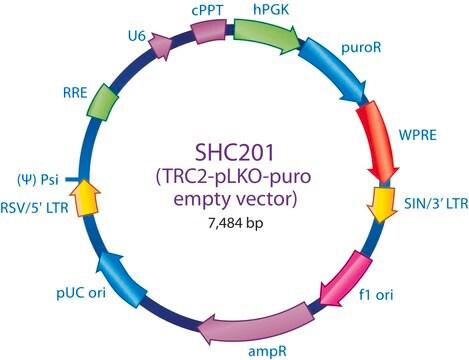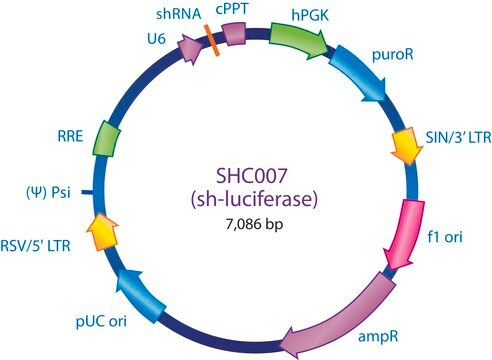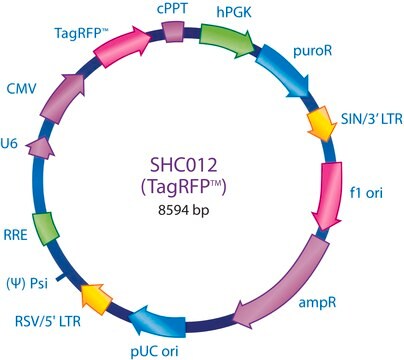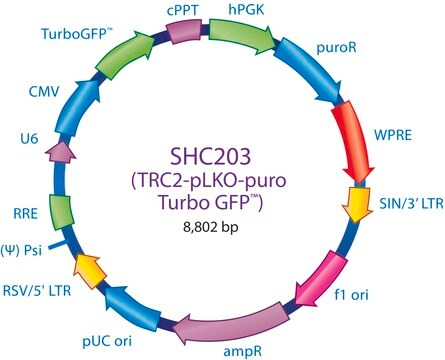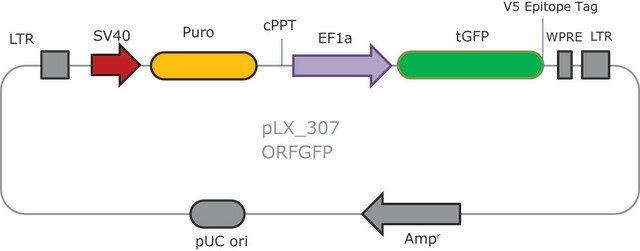SHC005
MISSION® pLKO.1-puro eGFP shRNA Control Plasmid DNA
shRNA sequence targeting eGFP
Synonym(s):
MISSION® Control Vectors
Sign Into View Organizational & Contract Pricing
All Photos(1)
About This Item
Recommended Products
Quality Level
product line
MISSION®
concentration
500 ng/μL in TE buffer; DNA (10μg of plasmid DNA)
shipped in
dry ice
storage temp.
−20°C
Looking for similar products? Visit Product Comparison Guide
Related Categories
General description
The MISSION® eGFP shRNA Control Vector is a 7,091 base pair lentivirus plasmid vector that contains an shRNA sequence targeting eGFP (GenBank Accession No. pEGFP U55761). The eGFP shRNA Control Vector is useful as a positive knockdown control in experiments using cell lines expressing eGFP.
Ampicillin and puromycin antibiotic resistance genes provide selection in bacterial or mammalian cells respectively. In addition, self-inactivating replication incompetent viral particles can be produced in packaging cells (HEK293T) by co-transfection with compatible packaging plasmids, MISSION® Lentiviral Packaging Mix (Prod. No. SHP001). The eGFP shRNA Control Vector is provided as 10 μg of plasmid DNA in Tris-EDTA (TE) buffer at a concentration of 500 ng/μl.
Ampicillin and puromycin antibiotic resistance genes provide selection in bacterial or mammalian cells respectively. In addition, self-inactivating replication incompetent viral particles can be produced in packaging cells (HEK293T) by co-transfection with compatible packaging plasmids, MISSION® Lentiviral Packaging Mix (Prod. No. SHP001). The eGFP shRNA Control Vector is provided as 10 μg of plasmid DNA in Tris-EDTA (TE) buffer at a concentration of 500 ng/μl.
Application
To see more application data, protocols, vector maps visit sigma.com/shrna.
Legal Information
Use of this product is subject to one or more license agreements. For details, please see http://sigmaaldrich.com/missionlicense.
MISSION is a registered trademark of Merck KGaA, Darmstadt, Germany
recommended
Storage Class Code
12 - Non Combustible Liquids
WGK
WGK 1
Flash Point(F)
Not applicable
Flash Point(C)
Not applicable
Certificates of Analysis (COA)
Search for Certificates of Analysis (COA) by entering the products Lot/Batch Number. Lot and Batch Numbers can be found on a product’s label following the words ‘Lot’ or ‘Batch’.
Already Own This Product?
Find documentation for the products that you have recently purchased in the Document Library.
Customers Also Viewed
Myoferlin regulates cellular lipid metabolism and promotes metastases in triple-negative breast cancer.
Blomme A
Oncogene, 36(15), 2116-2130 (2017)
Nhu Nguyen et al.
Oncotarget, 7(52), 86300-86312 (2016-11-20)
SETBP1 missense mutations have been frequently identified in multiple myeloid neoplasms; however, their oncogenic potential remains unclear. Here we show that expression of Setbp1 mutants carrying two such mutations in mouse bone marrow progenitors efficiently induced development of acute myeloid
Alexandra Veloso et al.
Cell death & disease, 10(7), 512-512 (2019-07-06)
Muscle formation is controlled by a number of key myogenic transcriptional regulators that govern stage-specific gene expression programs and act as terminal effectors of intracellular signaling pathways. To date, the role of phosphatases in the signaling cascades instructing muscle development
Huizhi Wang et al.
Oncogenesis, 9(8), 76-76 (2020-08-28)
Methyl-CpG-binding protein 2 (MeCP2) has been characterized as an oncogene in several types of cancer. However, its precise role in pancreatic ductal adenocarcinoma (PDAC) remains unclear. Hence, this study aimed to evaluate the potential role of MeCP2 in pancreatic cancer
Arnaud Blomme et al.
Oncotarget, 7(50), 83669-83683 (2016-11-16)
Exosomes are communication mediators participating in the intercellular exchange of proteins, metabolites and nucleic acids. Recent studies have demonstrated that exosomes are characterized by a unique proteomic composition that is distinct from the cellular one. The mechanisms responsible for determining
Our team of scientists has experience in all areas of research including Life Science, Material Science, Chemical Synthesis, Chromatography, Analytical and many others.
Contact Technical Service





